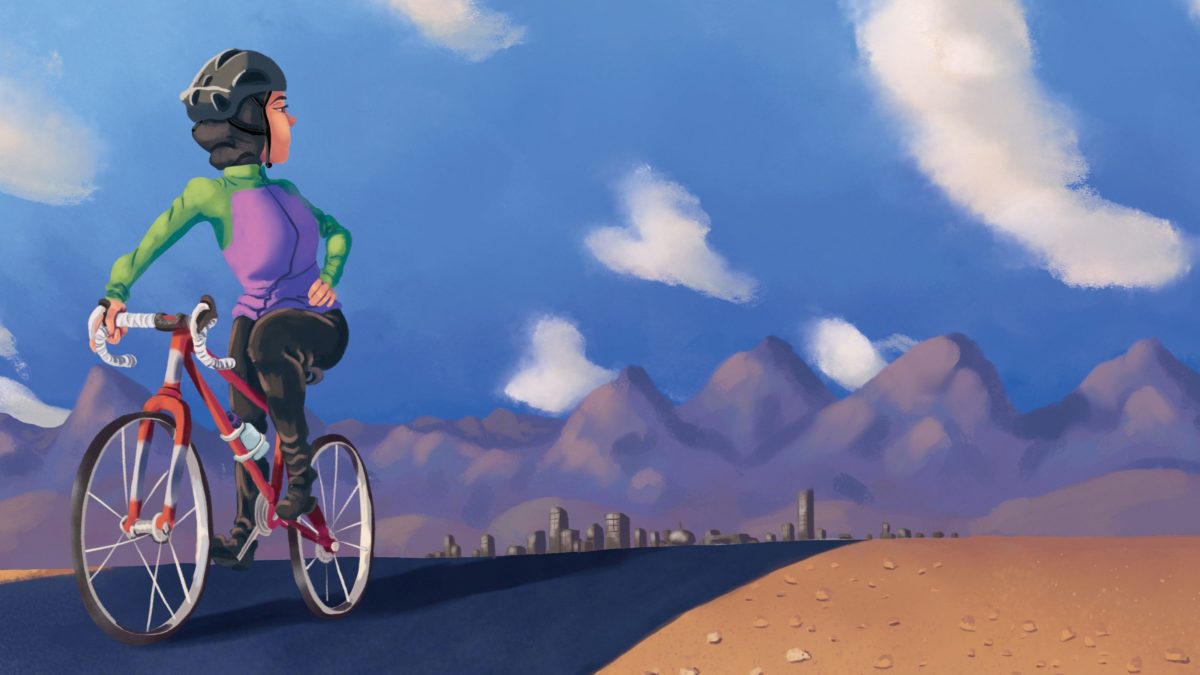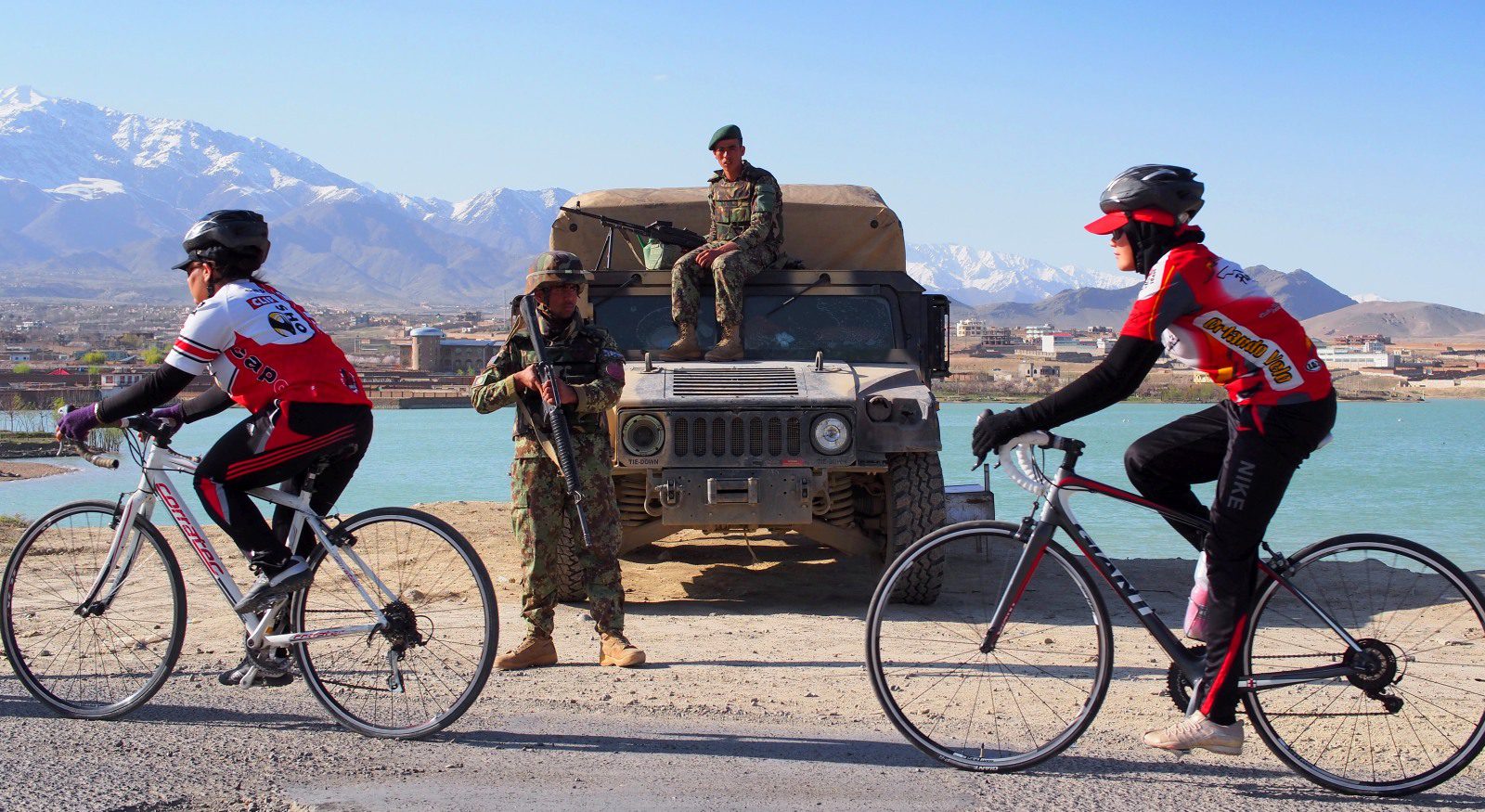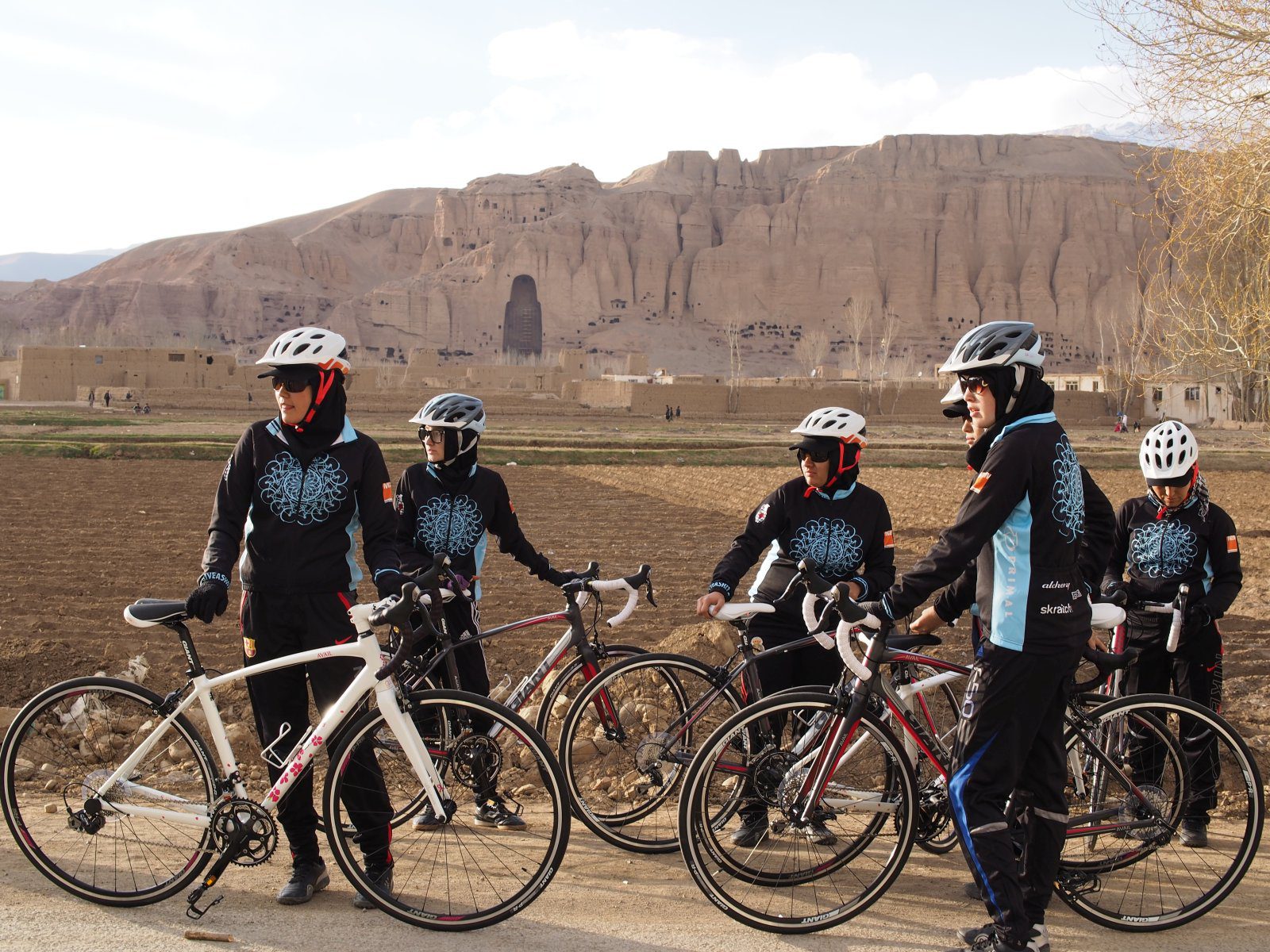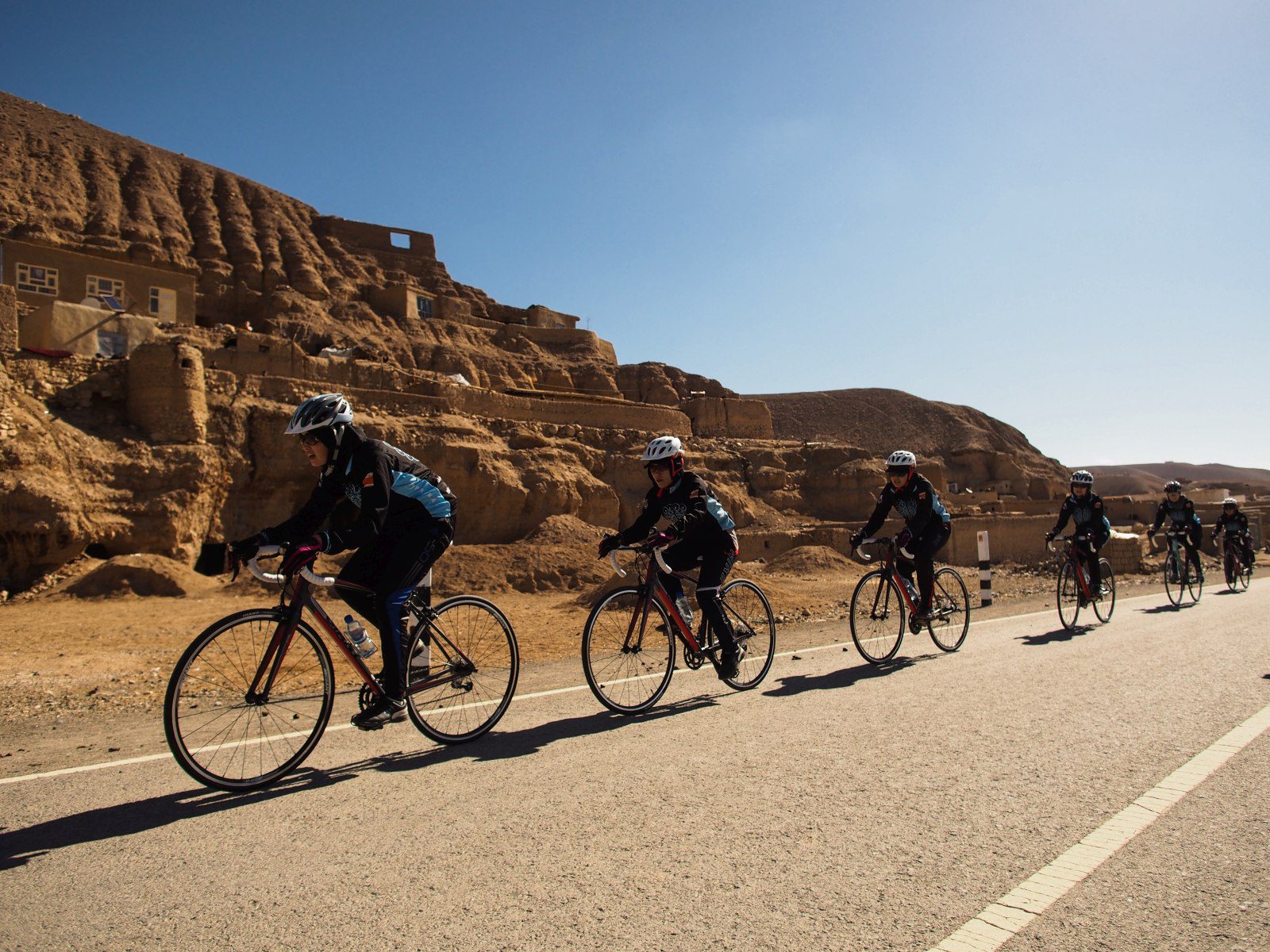The plight of women cyclists after Afghanistan’s fall
After many riders fled their country, their struggles continue. Some are trying to rebuild their lives in new countries. Others are working to free teammates and family living under the Taliban. Through it all, bikes remain vehicles of hope and freedom
 Photo by:
Jordan Peterson
Photo by:
Jordan Peterson
by Molly Hurford
On Aug. 15, Narges was halfway into a ride at a training camp in Jalalabad, panting up a hill, when she got the call: the Taliban had taken Kabul. Within minutes, she had abandoned her bike and jumped into a taxi, speeding for home. Once there, she started searching for her passport before frantically pulling her cycling gear – clothing, papers, medals, any indication that she rode – out of drawers and closets and stuffing it in a barrel in her small backyard. She lit it on fire before finally taking her documents and her two-year-old daughter, leaving behind the home and life she knew. All because she was a woman who dared to ride her bike in Afghanistan.
That was just the beginning of her six-day journey to the U.S. aided by the organization MTB Afghanistan. Today, Narges worries about where she will go, how she and her husband will provide for their daughter, and what will become of her sister, a single woman with three young children still in Kabul. (To protect the women interviewed in this story, last names are omitted as well as any location details that could impede evacuation or immigration efforts.) From a refugee camp, she sends me pictures of her former life in Afghanistan, and at first, she seems happy. There’s one image of her on a mountain bike, riding freely. In others, she’s modelling in gorgeous, ornate gowns, posed on cliffsides. She’s surrounded by friends with road bikes. Her daughter is rolling around a parking lot on a balance bike, with that joyful look of first discovering freedom.
“I hid my cycling equipment before I left. My life was in danger. If the Taliban knew I was a cyclist, I don’t know what they would do to me.”
But then, the photos change. A close-up shot of a gash on her head, where she was cut as men threw stones at her just for riding her bike. Photos of her sister and her small children, looking scared and uncertain. Photos of her own child, tears streaming down her face as she tries to blink away the tear gas thrown into the airport by Taliban fighters as they tried to flee. “We got to the airport and I thought my child was going to be crushed in the crowd,” she tells me matter of factly. “There was tear gas and we waited for days, and finally, we left the airport and hid in a nearby overturned fruit stall until it was quieter. We were there for two days with only a little water and biscuits.”
Narges started riding in 2014, and quickly improved – so much so that she joined the national cycling team as one of the first women riders. “When I started, it was hard. I come from a conservative family and they didn’t want me riding bikes. But I used to watch cycling on TV and saw the Tour de France and wanted to be like those riders,” she says. “Eventually, my father accepted it and supported me, as did my husband.”

“I started on a road bike, but I love to mountain bike now. It has so much more energy and action,” she says. “My husband also mountain bikes, and we ride together often. He wants to be an example to encourage other men who don’t allow their wives to ride bikes to change their minds.”
When she started riding, it was primarily with a few male cyclists, but eventually a few other girls began to join her. “There aren’t a lot of bikes or bike equipment, especially in more remote areas,” she says. “So when my husband and I would travel, we would buy extra equipment when we could and bring it back to the women in our area, to encourage them to ride.” Even then, her own bike – an upgrade from her heavy pieced-together first bike – was second-hand. “You don’t get brand new bikes here,” she says simply.
As the Taliban’s takeover of the country continues, equipment isn’t the issue. Now, cyclists are fleeing for their lives. Women cyclists – along with their families and the male cyclists who’ve supported them – are desperately trying to find refuge around the world. With little political support and rapidly shifting rules, regulations and methods of transport, it’s – as activist and organizer Shannon Galpin puts it – “absolute fucking chaos.” If hundreds of women athletes can’t make it out of Afghanistan safely as soon as possible, they will likely face violence as rights, protection and support for women disappears quickly. The women I spoke to feared that staying in the country was akin to a death sentence.
As the Taliban regained power in August, the progress that had been made by women in Afghanistan started to be undone. Even in the first days of the Taliban takeover, there were reports of Taliban fighters going door to door, already reimposing strict laws against women in many parts of the country, closing schools to girls even as they claimed that women’s freedoms would be allowed “within Islamic law.”
In the past decade, Afghan women cyclists boldly showed that women belong on bikes. They were honoured as National Geographic Adventurers of the Year. They were nominated for the Nobel Peace Prize. Now, they are hiding, they are fleeing, they are burning their kits, they are destroying any evidence that links them to the cycling culture.
Maryam also started cycling in 2014 in the Bamyan region. She joined the national team after competing in a provincial race in 2015. “I was so happy when I started riding. When I became the first in this competition, my dream was to be a strong athlete and the best in the country,” the now-21-year-old says. “Since then, I’ve improved a lot as a rider and taken part in many other sports, but also helped change the minds of people who believed girls shouldn’t ride bikes.”

Along with 18 other cyclists, Maryam was able to flee Afghanistan in early September. “I hid my cycling equipment before I left. My life was in danger. If the Taliban knew I was a cyclist, I don’t know what they would do to me,” she says. “Girls can’t even leave the house without a man with them now. But getting out of the country wasn’t easy. It was hard to get money to leave. We were turned away at a few borders. The entire time, we had to keep our faces completely covered. Because I am Hazara [an ethnic group typically targeted by the Taliban] and a known cyclist, it was so much more dangerous. I couldn’t take a deep breath for the three days before we were able to cross a border. We were beaten by the Taliban at one of the checkpoints. I was ill while we travelled, and we were on the road in the shuttle van for days.”
Sadiqa, the former captain of the national team, was in India for school – in her third year studying economics – as the evacuations began. Originally, her plans included returning to Afghanistan to be a businesswoman while still competing as a cyclist. Now, she doesn’t know what the next week or the next year will bring. “After the Taliban took over, I was not really well, mentally and physically,” she says. “I couldn’t sleep. I was crying all the time, worried for my family, my friends, my teammates.”
“We often forget how powerful the bicycle is, but it isn’t just about sports, it isn’t just about commuting. It’s about how we can plug into a community.”
She began riding in 2013, first using a bike to ride to school. She quickly fell in love with the sport and the freedom cycling brought her. “In the beginning, it was really tough for us. I used to wear my father’s clothes to ride. But he allowed that,” she says. “My uncle taught me how to ride a bicycle – I was lucky to have a family that supported my riding. I learned that there were other girls riding in Bamyan, so I joined them and we started to make a team. Shannon Galpin helped us get bicycles. In 2016, I created my own team called عقاب, which means Eagles. We had a lot of girls on the team, and we’d practise every day, even during the Ramadan months when we were fasting all day. I wanted to promote cycling culture, and also represent women’s empowerment in Afghanistan. I created some cycling tournaments and campaigns to encourage youth, especially women but also young boys, to start riding.”
While much of the focus is on the women cyclists, the men on Afghanistan’s national cycling team are similarly at risk for having trained alongside these women and for encouraging them. One of these male riders, Amin (his alias for this story), was seeking asylum in Europe this past October. “Afghanistan has a traditional community and people’s opinions are like a raging river,” Amin says. “Doing things that are against tradition is like swimming against the water in this river. In recent years, when Afghanistan has had relative stability in some provinces, a number of girls began riding to get their basic right, freedom. They rode to school, as transportation, as well as for sport. There were always people who didn’t like that, but there were also family, friends who helped those girls to get their freedom.”

While the Taliban has made pronouncements that it will still allow women some freedoms in the new regime, few believe it. Its actions thus far – banning women from studying in the same classrooms as men, telling them to stay home from work and banning some from their jobs altogether – cast doubts that the latest incarnation of the Taliban will be any different from the previous one. “There is no chance that the Taliban will allow girls to ride bikes when they don’t allow them to go to work or school as usual,” Amin says. “They tell the whole world that they have changed, but as that Afghan proverb says, ‘The donkey is the same donkey – only its saddle has changed.’ This is just the beginning and it will be worse than it is right now. Afghan cyclist women still in Afghanistan are living in fear for their lives.”
The fall of Kabul to the Taliban, the withdrawal of U.S. troops – the news cycle can make the story in Afghanistan seem as if it’s over. Commentators are now arguing over what the U.S., Canada and other nations should have done. Meanwhile, all over the world, human rights organizations, individuals such as Shannon Galpin and the organizers of MTB Afghanistan work without sleep as they try to get more women out of the country to safety, and then try to ensure that once they have left Afghanistan, they have somewhere to go. This work requires connections – political and behind-the-scenes – as well as money for security, documents, legal fees for applications for asylum, and flights to new lives, starting over with nothing.
“We had to leave everything behind,” Narges says. “As cyclists, we want to regain access to cycling so we can continue what we love to do. As humans, everything is uncertain for us, but we want to do what we love, we want to work and earn a living.”
“These women were told to seize every opportunity,” Galpin says. “They were told to get an education. They were told to learn to ride a bike, even though it’s taboo. And they deserve that chance.”
“As cyclists, we want to regain access to cycling so we can continue what we love to do. As humans, everything is uncertain for us, but we want to do what we love, we want to work and earn a living.”
Riding is no longer just about transportation or a racing goal. For these women, cycling has become about taking back power when they’re feeling powerless. “After the Taliban came back, I asked my neighbour here in India if I could borrow his bike,” says Sadiqa, whose bike was damaged in 2019 while at school. “As soon as I started riding, it gave me a feeling of power. Now, girls can’t cycle in Afghanistan, but I can ride for them. I do this for them. We have these big dreams, but we don’t have any future in Afghanistan anymore.”
Every person who has gotten out of the country has left a family member or close friend behind. They continue to worry about those in Afghanistan. Sadiqa shares the story of her teammate who hasn’t made it out yet. At 16 years old, this teammate is forced to contemplate marriage to her cousin (“a nice man”) in order to avoid being married off to a Taliban fighter instead. Narges, from her cot in the refugee camp in the U.S., thinks of her sister, a single woman with three young children who now can’t work or even leave the house without a man. Narges worries about her sister’s ability simply to survive. Toward the end of August, an estimated 14 million Afghans were experiencing food instability. Maryam’s husband remained in Afghanistan. She doesn’t know when they’ll be reunited, though she maintains faith that they will be. Her sister, a runner, is still in Afghanistan and Maryam is also afraid for her, as well as for her other six siblings. Each woman has at least one teammate who’s impossible to reach. It’s unclear if they’ve managed to get out of the country, if they’re in hiding, or worse.
To fund the efforts to help these women out of Afghanistan, then settle in safe spots around the globe and eventually help them rebuild their lives and passion for cycling, Galpin started the Support Evacuation and Resettlement of Afghan Cyclists fundraising campaign. It had raised more than US$118,000 by late-October. MTB Afghanistan, an U.S.-based organization, has done the same, as have other endurance sports groups around the world. Galpin reports that each evacuation cost roughly US$5,000, and that’s just to get women out of the country. She believes that the cycling community can be galvanized to find communities for these women. “Cycling is at its best when it’s building community,” she says. “We have a moral obligation to support these athletes, these human rights defenders. And it’s not just about supporting the women, it’s about supporting their families.”
U.S. Army veteran and longtime bike mechanic Dan Horndasch has been helping Galpin in the effort, using every channel possible to arrange transport out of the country. “Right now, the main goal is simply to get these women out. We need to get them out of Afghanistan, and it doesn’t matter where they land,” Horndasch says. “Once they safely get to Point B, we can figure out where to send them, where they can have a safe haven. After that, these women will be rebuilding from nothing – and the cycling community can help.”

“We already have members of the Afghan national team living as refugees in Germany, Sweden and France. We’ve seen that when they are supported and plugged into the bike communities, they thrive,” Galpin says. “The bicycle has been the conduit to building community, learning languages and having friendships. We often forget how powerful the bicycle is, but it isn’t just about sports, it isn’t just about commuting. It’s about how we can plug into a community. It’s how we share a common humanity. This is not a situation where we can be distracted and look away, and need to recognize that. We have a moral obligation to help, until they don’t need help anymore.”
“They rode to school, as transportation, as well as for sport. There were always people who didn’t like that, but there were also family, friends who helped those girls to get their freedom.”
In October, the UCI announced that – along with Montrealer and Israel Start-Up Nation co-owner Sylvan Adams, the NGO IsraAID, the Asian Cycling Confederation and various governments (including Canada’s) – it had helped 165 Afghans leave the country. That group of refugees included women cyclists, citizens involved in cycling management, a judge, artists, journalists and human-rights activists. At least 38 of these refugees went to Switzerland, while others headed to Canada, Israel, France and the U.S. The work to get more people out of Afghanistan, however, continues.
“My message to all the world is: do not leave the girls behind. Don’t let the Taliban take Afghanistan back to its dark days,” says Amin. “You can be the voice of those people who seem forgotten by the whole world.”
Despite everything, these women still have hope for their futures. “I will continue cycling, I will achieve my dreams and I will become successful,” Maryam told me in September over a crackling WhatsApp connection. “I am an Afghan girl. I am a millennial. I am an athlete. I am a human being. I will never forgive the Taliban for undermining our aspirations, separating us from our families, ignoring our rights as humans. We are scared for our families and friends, for our futures. But we will never give up, and we will have a bright future. We are the hope of our families and the hope of those who helped us, and we must be strong. I can repaint half-finished dreams.”
How you can help Afghan women cyclists
Donate
Support Evacuation and Resettlement of Afghan Cyclists
fundly.com/support-afghan-cyclists
MTB Afghanistan
mtbafghanistan.org
Act
Write or call your member of Parliament. Ask your MP to allow more refugees into the country and to assist in getting more of these women out of Afghanistan.
This story originally appeared in the December 2021 & January 2022 issue of Canadian Cycling Magazine
